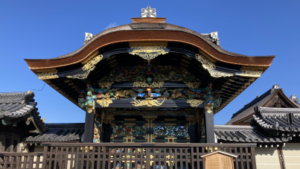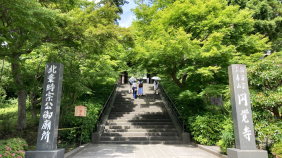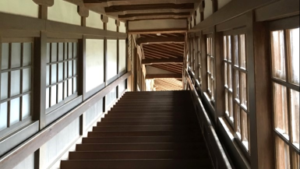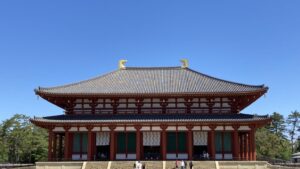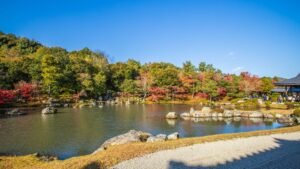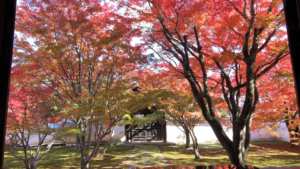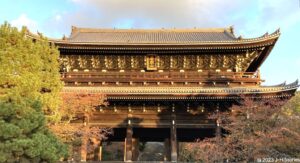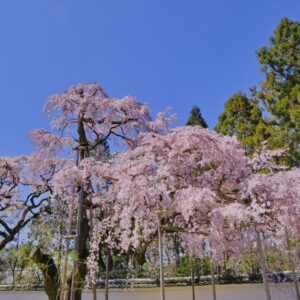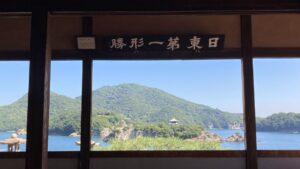Why Was Horyuji Temple Built by Prince Shotoku?
Horyuji Temple, the World's Cultural Heritage Site, is the oldest wooden structure in the world and one of the Buddhist Monuments in the Horyuji area, that has retained its beauty unchanged for almost 1,400 years. It consists of 48 buildings, including the Kondo (Main Hall), the Five-story Pagoda, the Middle Gate, and the East and […]
Three Karamon Gates Reflect Hideyoshi's Authority as a Ruler
Kyoto is home to three national treasures of Karamon Gates at Daitokuji Temple, Nishi-Hongwanji Temple, and Toyokuni Shrine. These gates were relocated from Toyotomi Hideyoshi’s retreats, Jurakudai and Fushimi Castles. Toyotomi Hideyoshi (1537–1598, 豊臣秀吉) ended over a century of warlike period in Japan. The Karamon Gates feature the distinctive Karahafu, an undulating bargeboard on the […]
Engakuji Temple: A Monument to Japan’s Victory Aginst the Mongols
Engakuji Temple, ranked second among the Five Great Zen Temples of Kamakura, is located near Kitakamakura Station. It was founded in 1282, a year after Regent Hojo Tokimune overcame two Mongol invasions, intending to protect the nation, promote Zen teachings, and mourn for all war victims on both sides. Upon entering through the Sanmon gate, […]
Eiheiji Temple, Training Center of Soto Zen Buddhism
Eiheiji Temple located deep in mountains is a training center of Soto Zen. You will confront yourself through Zazen Meditaion and also daily practices.
Kohfukuji, 1,300 Years of Fujiwara Clan's Temple and Its Attractions
Kohfukuji Temple in the heart of Nara is a treasure trove of over 30 National Treasures, including the majestic Chukondo Hall, the five-story pagoda, as the influential Fujiwara clan who had stood at the center of power for over 1,300 years. Don't miss out on exploring the beginning of Fujiwara clan's prosperity starting Kamatari and Fuhito.
Tenryuji Temple, Shogun Ashikaga Takauji Mourned Emperor Go-Daigo
Located at Arashiyama, Shogun Ashikaga Takauji built Tenryuji Temple to mourn Emperor Go-Daigo. Sogen pond garden and Could Dragon painting are specutacler.
Myokakuji Temple, Nobunaga's Innovative Venue for Tea Ceremonies
Oda Nobunaga held his tea ceremonies at Myokakuji Temple, his lodging during his stay in Kyoto. Here, Nobunaga and Sen-no-Rikyu met. The two innovators began to resonate with each other in their rational minds. Nobunaga appointed Rikyu as the tea master for the tea ceremony held at Myokakuji Temple in 1573. Encounter between Nobunaga and […]
Chion-in Temple, Honen's Teaching to Save the People
Chion-in Temple, the head temple of the Jodo sect, is located at the foot of Mt. Higashiyama in Kyoto, built by Tokugawa Ieyasu (1543-1616, 徳川家康) by allotting the temple grounds of Shorenin Monzeki. Hidetada, Ieyasu's successor, donated to the construction of the temple gate, known as Sanmon (三門) or the Three Gate, the largest gate […]
Daigoji Temple, Cherry Blossoms Honoring Hideyoshi's Unification of Japan
Daigoji Temple, a World Heritage Site, has been known as Hana-no-Daigo (Cherry Blossom Flower Daigo) since the Heian period (794-1185), and some 700 cherry blossoms are in full bloom in spring, including weeping, Someiyoshino, mountain, and double-flowered cherry trees. The temple consists of several sub-temples and gardens spreading across a vast area of Mt. Daigo […]
Taichoro, The Most Beautiful Guest Room Admired by the Korean Envoy
The view from Taichoro at Fukuzen-ji Temple, a reception hall and the guest lodge for the Korean Envoy, is a dignified beauty like a picturesque landscape framed by wooden columns. This scenic vista extends to the Sensuijima and Benten-jima islands in the east, while the Shikoku Mountains are in the distance, overlooking the Seto Inland […]


